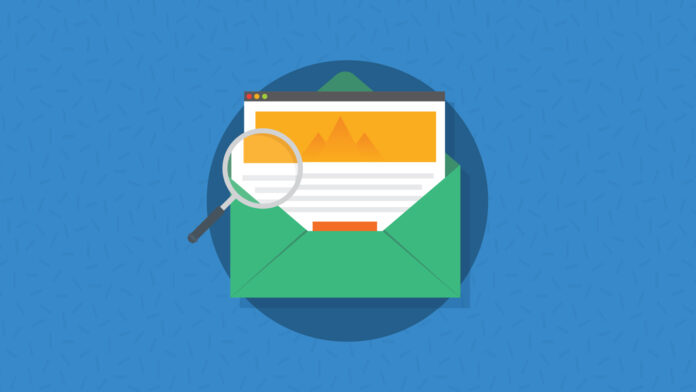Create your very own Auto Publish News/Blog Site and Earn Passive Income in Just 4 Easy Steps
The word “audit” doesn’t exactly bring up feelings of joy and excitement does it? If you’re being audited, it means you could be in trouble. And if you’re doing the auditing, it often means you’re facing a tedious task. But what is an email marketing audit?
If you’re here looking for information on how to audit emails, you might be dreading the project and feeling a little overwhelmed. But if you break it down into simple steps and stick with it, you’re going to learn a lot about your subscribers and your email strategy.
We’ll be straight with you here. Email audits do take time and effort. However, they also reveal the inner workings of a brand’s email program, uncovering places to make improvements and highlighting your biggest wins.
Instead of thinking of an email audit as a chore, imagine you’re on a treasure hunt or unraveling a mystery. You’re part detective and part archeologist… like Indiana Jones heading out on an adventure to find the truth.

Jump to a section in this article:
Defining email marketing audits
Put simply, the goal of an email marketing audit is to examine existing emails to find out what’s working and what’s not. You do this by reviewing email analytics as well as other data. An email audit typically includes but is not limited to:
- Overall performance of the entire email program
- Performance of individual campaigns and automated emails
- A review of your contacts (total number, marketable, and active subscribers)
- An evaluation of your list segmentation strategy
- A review of your email templates
- An analysis of email’s impact on business goals
Ultimately, you can define what needs to be audited. You may want to review the copy and design. Or, you could examine existing workflows to determine how well a series of automated emails work together.
So what is an email audit? It’s digging up stats, crunching the numbers, and coming to conclusions about the successes and shortcomings of your strategy and execution.
Why conduct an email marketing audit?
As you get caught up in the hustle of email marketing, it’s easy to become bogged down in the details. When you’re hyper-focused on the latest campaign or newsletter, it’s hard to “see the forest for the trees” as they say.

An email audit breaks everything down into manageable pieces and then reassembles them into a holistic picture. You’ll emerge with a better understanding of the health of the entire email program as well as the ability to pinpoint problems.
Beyond the standard email performance numbers, here are several things an email marketing audit could reveal:
- Deliverability issues
- The need for better email list hygiene
- Emails or tactics that prompt people to unsubscribe
- Outdated copy and design:
- Incorrect information
- Offbrand design elements
- Rendering issues with certain email clients and devices
- Poor user experience:
- Email accessibility
- Broken links
- Website content that needs to be refreshed
Of course, an email audit is going to point you towards plenty of opportunities as well. Every time you find something “wrong” during an email audit – be happy. You just found a way to make your program even better.
When to conduct an email marketing audit
The frequency of in-depth email audits will depend on time, resources, and the complexity of your program. However, it’s smart to conduct an email audit at least once every year.
For many marketers, that space between the end of the holiday email rush and the start of the New Year is the perfect time to take a look at everything. You may also want to do a mid-year check-in. Some teams audit their email on a quarterly basis. Others conduct a major audit annually and update the essentials each quarter.
Another important time to audit emails is after starting a new job or getting promoted to a role that involves strategy and leadership. Over the years, Email on Acid’s senior email marketers conducted full audits when they started. That included Paul Kirby back in 2018.
Those first few weeks in a new job can feel like you’re “drinking from a firehouse” as they say. But an email marketing audit can help you break things down into manageable gulps.
 Day 1 at the new job.
Day 1 at the new job.
In addition to the annual audit, Paul recommends reviewing performance monthly so that you stay ahead of potential problems and spot opportunities throughout the year.
“Try to do a monthly analysis of what emails you sent out and what worked. I’m obsessive about tracking that kind of information, and I’m constantly looking at email performance to see what’s driving growth, or what changes need to be made if there’s a drop-off.
“The in-depth email marketing audit you do at the start of a new role isn’t something you need to repeat often, but it’s important always to be looking at how customers are engaging with your emails and make gradual changes to optimize.”
~ Paul Kirby, Email Marketing Manager
Getting started with an email audit
Auditing emails can quickly get tricky. Before you dive in, you’re going to need a plan. Here are four steps to help you begin your email marketing audit:
1. Define your goals
What do you want to learn from the email audit? Perhaps there’s a specific problem, such as low engagement or a high unsubscribe rate, and you want to find out why that’s the case.
Picture yourself in the future at the end of the audit. What will you know then that you don’t know now? Establishing that goal at the beginning of the auditing process will help you stay focused as you explore things like data, designs, and deliverability.
2. Choose your KPIs
Which metrics will you use to evaluate your overall program and individual emails? What makes an email successful? Pick the key performance indicators (KPIs) that are most likely to help you achieve the goal of your email audit.
Keep in mind that not all emails are created equal. Ask yourself what you expect success to look like for different types of emails. For instance, a welcome email series and abandoned cart emails may see higher engagement than promotional emails or newsletters. So, you shouldn’t measure every email against the same standards.
Consider bucketing emails into different types. For example:
- Transactional emails
- Promotional emails
- Newsletters
- Nurture tracks
- Onboarding/product education
- Reengagement
An important caveat for measuring email performance in 2022 is the lack of reliability for open rates and click-to-open rates (CTOR). Changes from Apple Mail Privacy Protection mean you won’t be getting accurate data connected to email opens for a significant percentage of subscribers.
Choose metrics that reflect what happens after the email is opened. That’s obviously going to include clicks on links in the email. However, you could also analyze email engagement metrics like the glance/delete, skim, and read rates. Heatmapping is another useful way to explore how subscribers experience your emails.
3. Consider your target audiences (segments)
Just as different types of emails have different results, certain groups of subscribers will react differently to your emails.
Part of your email audit could include stats based on the segments you’re targeting. Are female shoppers responding more to promotional campaigns than males? Do people from a specific geographic location unsubscribe more often? How do decision-makers engage with your emails compared to other segments?
Foundational knowledge of your various segments and lists is certainly helpful during an email audit, but the audit can also reveal new information about the people you want to reach.
“Even more than understanding CTRs and open rates, knowing who your customers are is the most important piece of data. But it doesn’t end once the audit is complete – understanding your customers is an ongoing analysis.”
~ Paul Kirby, Email Marketing Manager
4. Start a spreadsheet
Once you’ve defined the goals and chosen the right metrics and segments, it’s almost time to start digging in and evaluating emails. Love them or hate them – spreadsheets are going to be the best way to collect and compile all that data.
Here’s what email expert Nout Boctor-Smith suggests for the rows and columns on your sheets:
- Email campaign name
- Date deployed (not needed for automated emails)
- Segment or target list
- Subject line
- A/B test (if applicable)
- Number of emails sent
- Hard bounce rate
- Soft bounce rate
- Unique open rate*
- Unique click-through rate
- Click-to-open rate*
- Unsubscribe rate
- Conversion rate
* Apple Mail Privacy Protection may impact the accuracy of these metrics.
You can use some of the factors above (those that are measurable KPIs) to create an email audit checklist. As you evaluate each email, go down the list, find the numbers you need, and enter them into the spreadsheet. Now you can filter and compare the data.
For more advice on using spreadsheets and the nitty-gritty of email program evaluation, check out Nout’s article on how to conduct an email audit.
How to audit emails
The easy part of your email marketing audit will most likely be those big picture numbers that reflect your total efforts throughout the past year. You should be able to grab that data quickly from your email service provider (ESP), customer relationship management (CRM) software, or marketing automation platform (MAP).
The tedious part of the audit involves examining each email individually. But this is also where things start to get interesting. In addition to looking at statistics, it’s wise to open the email and experience it as your subscribers do.
Here are some questions to ask as you audit individual emails.
Content and design:
- How does the email design look?
- How does the body copy sound/read?
- Is there intuitive information architecture?
- Are content and landing pages linked to from the email still relevant?
- Is there a consistent experience between email and web content?
- Is the email accessible to all subscribers?
Segmentation:
- Which buyer personas, demographics, or other groups are the intended targets?
- Was the email sent to a highly defined or broad list of subscribers?
- Are the email’s design and content general or created for a specific segment?
Performance:
- Are the subject line and preheader text working (opens)?
- Do subscribers engage with the email content (read, skim, delete)?
- Are calls to action in the email doing their job (clicks)?
- Does the email annoy or frustrate subscribers (unsubscribes)?
Results:
- Did the email achieve its intended goal?
- Send traffic to the website
- Boost sales or increase signups
- Improve brand/product awareness
- Build loyalty
- Inform/educate customers
- Reduce churn
- Etc.
To get all the answers to these questions, you may need to reach out to others in the organization. For example, designers can let you know if emails have bad branding, content marketers could suggest better articles to share, and sales will tell you if nurture emails help produce qualified leads.
What to do after an email audit
Once your email marketing audit is finally complete, you’ll face another challenge – what to do with all that information. So, what’s next? We suggest looking for some of the biggest areas of improvement as well as quick wins.
- Major areas for improvement: If there are glaring problems with an email program, those need to be addressed as soon as possible. These are often issues that directly impact the customer experience or revenue generation.
- Quick wins: These are smaller changes that will have an immediate impact on results. For example, sending subscribers to a landing page with a higher conversion rate, or changing the CTA button color based on split testing.
Paul Kirby recommends moving methodically through changes you make based on your email audit. Going too far too soon could have unforeseen consequences.
“Don’t try to make a sweeping change on everything right away – unless you’ve joined a company where the email marketing program is completely flat or needs a major shake-up. If you change too much too soon (design, frequency) you could shock the customer. You may also lose sight of what is working. I don’t like to make a huge change without running an A/B test first.”
~ Paul Kirby, Email Marketing Manager
When you do make changes to email templates and automated campaigns, don’t forget to test, preview, and optimize each one before it goes back into action.
Sinch Email on Acid provides an email readiness platform that eliminates send button anxiety thanks to an automated pre-send checklist that’s perfect for email teams. Use our reliable email previews to spot rendering problems on different clients and devices. Double-check spelling and catch accidental profanities. Optimize inbox display, improve email accessibility, and monitor potential deliverability issues.
Enjoy all these features along with the benefit of unlimited testing, which means you can test as many emails as many times as you need without ever hitting a limit.
Regular email pre-deployment testing catches lots of the issues that tend to creep up in email audits. So, if you’re testing all year long, next year’s email marketing audit is going to go much smoother.
This article was updated in January of 2022. It was first published as a Q&A in October of 2018.
![]()
Author: Kasey Steinbrinck
Kasey Steinbrinck is a Sr. Content Marketing Manager for Sinch Email, which includes the brands Email on Acid, InboxReady, Mailgun, and Mailjet. He understands how email and content work hand-in-hand to create a strong strategy. Kasey has also spent time working in traditional media, e-commerce marketing, and for a digital agency.
Create your very own Auto Publish News/Blog Site and Earn Passive Income in Just 4 Easy Steps






